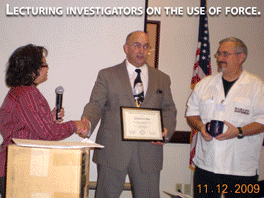 Unnecessary / Excessive Use of Force – A Working Definition
Unnecessary / Excessive Use of Force – A Working Definition
I am often asked to explain to people who are not police officers or lawyers the definition of unnecessary and excessive use of force. First, it is important to understand just what a use of force is. While many law enforcement agencies have their own definition, I have found that the simplest explanation is this: A use of force is an intentional act by a police officer who knows, or should know, may cause pain and/or injury to someone for the lawful purpose of controlling their actions. The force used maybe less-lethal or lethal / deadly force.
A police officer may use force when it is lawfully necessary to control the actions of another person. That force must be reasonable, justified, and within policy. When you hear the term “reasonable” used in this context, reasonableness refers to what a reasonable officer would do. A reasonable officer is basically defined as a typical officer, who in a similar situation will react in a similar fashion.
An example of unnecessary force: A police officer tells a suspect he is under arrest for a crime. The officer tells the person to turn around to be handcuffed. The suspect raises both fists and threatens the officer with harm. The officer properly takes out his baton and tells the suspect to submit or force will be used. The suspect sees the baton, tells the officer not to hurt him, and submits by doing as the officer ordered, i.e., the suspect fully cooperates. The officer, however, rather than simply handcuffing the man, hits him with the baton without just cause. That is unnecessary use of force, as no force was needed.
In a different scenario, once the officer tells the person he is under arrest, the suspect rushes the officer with his fists raised. As the suspect rushes the officer, the officer properly strikes the suspect with the baton once across the arms and the suspect immediately gives up and fully cooperates. However, once the suspect stops his attack and gives up, the officer strikes the suspect many times, when only one strike was needed. Here force was needed, but too much force was used. This is excessive force.
*****
While every effort has been made to ensure the accuracy of this information, it is provided for educational purposes and is not intended to provide legal advice.
About the author:
Richard Lichten (Lt. Retired) brings 30 years of front-line law enforcement experience to a wide range of police and jail topics. Twenty of his 30 years in the Los Angeles County Sheriff’s Department were in supervisory and command positions. Richard Lichten is deemed a qualified expert in the use of force, use of the Taser, police/jail practices, and jail/prison inmate culture in the State of California Superior Courts, State of Nevada Courts, State of Arizona Courts, State of Hawaii Courts, and in Federal Courts.
24355 Creekside Road, #801884
Santa Clarita CA 91380
661.406.7258
© 2009 - 2019 Police & Jail Procedures - All Rights Reserved
